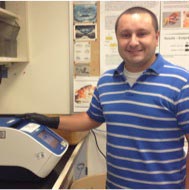
Name: Alejandro Lopez-Ceron
Education: B.S. in Marine Biology at Jorge Tadeo Lozano University in Colombia; M.S. in Oceanography at University of Cadiz in Spain; currently working on Ph.D. in Zoology at Colorado State University in the US.
Hometown: Bogota, Colombia
Career goal: Alejandro plans to take the molecular techniques he learns in Dr. Mykles’ lab back to his home country where such resources and technologies are limited. He hopes to apply these acquired skills to his studies on zooplankton, as well as to developing fields such as aquaculture, coastal management and ecology.
Favorite Memory: A favorite memory Alejandro recalls from his professional life was sampling and identifying marine zooplankton in Columbia or identifying marine neustonic zooplankton from around the world during his time in Spain. Studying zooplankton continues to be his passion. Alejandro notes that the most interesting aspect of Dr. Mykles’ lab is getting to work with crustaceans in a landlocked state. “It’s sort of funny, and also a challenge” he says, “because everything in the lab depends on these crabs staying alive.”
Project: Identify, characterize, and quantify the expression of AMPK subunits (alpha, beta and gamma) in the Y-organ over the molt cycle in the blackback land crab (Gecarcinus lateralis).
From Itty Bitty to Creepy Crawly
It may seem like a drastic transition to go from studying zooplankton to studying crabs, but in the sea of science, just about everything is connected. The currents of change carried Alejandro to the crab lab, as his wife began her PHD work at Colorado State University and introduced Dr. Mykles to Alejandro. Thus he dove into the biology of the land crab.
Energy: The Spark of Life
The research Alejandro is conducting for Dr. Mykles’ lab deals with a specific protein known as the AMP-Kinase protein. AMP-Kinases are found in a variety of invertebrates as well as vertebrates and serve a central purpose in sustaining life. The role of this protein is to regulate the ratio of ATP to AMP in the cell. ATP is the energy used by the cell to carry out all life processes. The AMP-Kinase protein plays a crucial role in how the cell’s energy is regulated and used efficiently.
Reading between the Lines
For his experiment, Alejandro is manipulating the specific conditions that the crab is in and then is looking closely at the AMP-Kinase protein to see how different conditions effect it. “Looking closely,” in this case means examining the sequence, or expression, of DNA. To begin the experiment, conditions such as temperature, salinity, and oxygen concentration are manipulated to provide the variable environmental conditions for comparison. Next, Y-organ tissues are extracted, and through molecular laboratory techniques the DNA is isolated. The DNA is then sequenced and analyzed. The sequencing results are a description of the crab’s genetic makeup at the point in time that the DNA was extracted. Analysis of this sequence shows which genes are expressed or not expressed, and provides a more accurate depiction of what is going on in the crab’s body during molting.
Applications
The research being done on the AMP-Kinase protein tells a lot about land crabs, as well as a wide array of animal phyla. The AMP-Kinase protein has not been analyzed before in any crustacean, so exploring this sequence will broaden the perspective of knowledge of the protein. In addition to broadening the scientific perspective, sequencing different proteins and exploring their functions uncovers a lot about molting and the gene expression involved in the process.
Primary Investigator
Undergraduate
Graduate
Ph.D.
- Astrid Wittmann
- Natalie Pitts
- Kathy Cosenza
- Samiha Benrabaa
- Alejandro Lopez-Ceron
- Nada Rifai
- Sunetra Das
